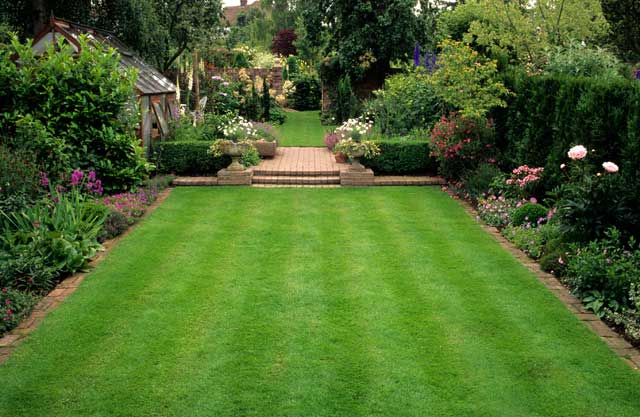Turf war: How to grow the perfect lawn

All beautiful lawns are alike: immaculately even green grass stretching smoothly away; effortless mowing lines, neatly edged; the sound of birdsong and a table laid for afternoon tea. It's the variety of ways a lawn can go wrong that is shocking. You only have to spend five minutes with Google to realise the sheer range of problems people report with their lawns: patches under trees that never flourish; mysterious yellowing where dogs have relieved themselves; accounts of unique green slime moulds right out of Fungus the Bogeyman. It seems that we all long for that proper 1950s granddad lawn. But is it just a fantasy? Or did they just have better chemicals then?
The primary reality of lawn-making is that grass needs a lot of sunshine. It's a simple equation – the more wear and tear you expect from your turf, the more sunshine it will need to repair itself. Premiership football teams with increasingly tall and shady stadiums face this problem, and they solve it with the help of a Dutch former rose-grower, Nico van Vuuren. He developed the huge banks of lights wheeled on to the pitch whenever the home team aren't playing. Even at night, they cast an unearthly glow over Arsenal's prize-winning Emirates turf.
Home gardeners are not going to run to six-figure growing lamps, but it is worth learning the lesson that turf without sunshine is, in the end, a losing battle. Whatever fertilisers or supplements you use, sometimes cutting back trees and hedges will provide the lifeline your lawn needs. Think about where the sunshine gets to your lawn, and consider the tactical removal of branches or even fencing.
Another piece of tested groundsmen's advice: seeded turf is vastly superior where lots of feet are going to be treading. Dogs, toddlers and teenagers all do their fair share of damage, and if you can possibly grow a lawn from seed, you root it more firmly for the future. (Some insiders put all Wembley's grassy woes of the past two years down to the constant replacement of turf there.) Do yourself a favour, and when the family goes away on holiday, think about seeding your lawn from scratch.
And don't ignore those granddad-approved techniques. Aerating the lawn, even just by making holes with a fork, can help most grass look better for longer. So can a scattering of sand, which will quickly be absorbed into the top surface, providing the sharper drainage grass needs.
Finally, improve your mowing practices. Don't leave the job for weeks then expect to be able to cut a bowling green. Take the level down in stages, with a week between each level change. It might not be the Emirates, but it will be an improvement. n
Live by the sward...
Aerate it
Enlist the children by treating them to lawn-aerating shoes, £11.99 from Greenkey. On the other hand, it might actually get done quicker with a rolling aerator, £27.99 also from Greenkey. greenkey-garden.co.uk
Feed it
Grass does a lot of work, and you handicap it every time you cut it. So give something back to your lawn, preferably in the shape of fertiliser. Choose an organic one such as Lakeland's own brand and you won't need to feel quite so bad about dousing the worms. £6.99, lakeland.co.uk
Design it
Sculptor David Parfitt provides 15 different designs for lawn-mowing in The Art of the Lawn: Mowing Patterns to Make Your Lawn a Work of Art (David & Charles, £9.99)
Subscribe to Independent Premium to bookmark this article
Want to bookmark your favourite articles and stories to read or reference later? Start your Independent Premium subscription today.

Join our commenting forum
Join thought-provoking conversations, follow other Independent readers and see their replies